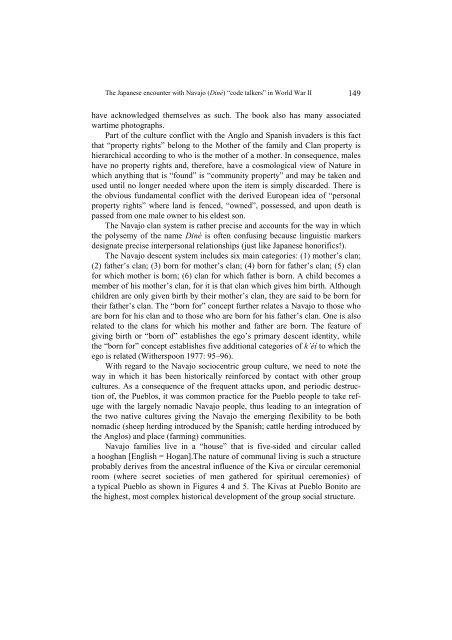s - Wyższa SzkoÅa Filologiczna we WrocÅawiu
s - Wyższa SzkoÅa Filologiczna we WrocÅawiu
s - Wyższa SzkoÅa Filologiczna we WrocÅawiu
Create successful ePaper yourself
Turn your PDF publications into a flip-book with our unique Google optimized e-Paper software.
The Japanese encounter with Navajo (Diné) “code talkers” in World War II 149<br />
have acknowledged themselves as such. The book also has many associated<br />
wartime photographs.<br />
Part of the culture conflict with the Anglo and Spanish invaders is this fact<br />
that “property rights” belong to the Mother of the family and Clan property is<br />
hierarchical according to who is the mother of a mother. In consequence, males<br />
have no property rights and, therefore, have a cosmological view of Nature in<br />
which anything that is “found” is “community property” and may be taken and<br />
used until no longer needed where upon the item is simply discarded. There is<br />
the obvious fundamental conflict with the derived European idea of “personal<br />
property rights” where land is fenced, “owned”, possessed, and upon death is<br />
passed from one male owner to his eldest son.<br />
The Navajo clan system is rather precise and accounts for the way in which<br />
the polysemy of the name Diné is often confusing because linguistic markers<br />
designate precise interpersonal relationships (just like Japanese honorifics!).<br />
The Navajo descent system includes six main categories: (1) mother’s clan;<br />
(2) father’s clan; (3) born for mother’s clan; (4) born for father’s clan; (5) clan<br />
for which mother is born; (6) clan for which father is born. A child becomes a<br />
member of his mother’s clan, for it is that clan which gives him birth. Although<br />
children are only given birth by their mother’s clan, they are said to be born for<br />
their father’s clan. The “born for” concept further relates a Navajo to those who<br />
are born for his clan and to those who are born for his father’s clan. One is also<br />
related to the clans for which his mother and father are born. The feature of<br />
giving birth or “born of” establishes the ego’s primary descent identity, while<br />
the “born for” concept establishes five additional categories of k’éí to which the<br />
ego is related (Witherspoon 1977: 95–96).<br />
With regard to the Navajo sociocentric group culture, <strong>we</strong> need to note the<br />
way in which it has been historically reinforced by contact with other group<br />
cultures. As a consequence of the frequent attacks upon, and periodic destruction<br />
of, the Pueblos, it was common practice for the Pueblo people to take refuge<br />
with the largely nomadic Navajo people, thus leading to an integration of<br />
the two native cultures giving the Navajo the emerging flexibility to be both<br />
nomadic (sheep herding introduced by the Spanish; cattle herding introduced by<br />
the Anglos) and place (farming) communities.<br />
Navajo families live in a “house” that is five-sided and circular called<br />
a hooghan [English = Hogan].The nature of communal living is such a structure<br />
probably derives from the ancestral influence of the Kiva or circular ceremonial<br />
room (where secret societies of men gathered for spiritual ceremonies) of<br />
a typical Pueblo as shown in Figures 4 and 5. The Kivas at Pueblo Bonito are<br />
the highest, most complex historical development of the group social structure.
















